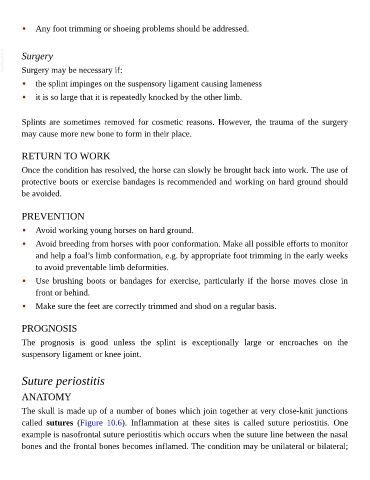Page 437 - The Veterinary Care of the Horse
P. 437
• Any foot trimming or shoeing problems should be addressed.
VetBooks.ir Surgery
Surgery may be necessary if:
• the splint impinges on the suspensory ligament causing lameness
• it is so large that it is repeatedly knocked by the other limb.
Splints are sometimes removed for cosmetic reasons. However, the trauma of the surgery
may cause more new bone to form in their place.
RETURN TO WORK
Once the condition has resolved, the horse can slowly be brought back into work. The use of
protective boots or exercise bandages is recommended and working on hard ground should
be avoided.
PREVENTION
• Avoid working young horses on hard ground.
• Avoid breeding from horses with poor conformation. Make all possible efforts to monitor
and help a foal’s limb conformation, e.g. by appropriate foot trimming in the early weeks
to avoid preventable limb deformities.
• Use brushing boots or bandages for exercise, particularly if the horse moves close in
front or behind.
• Make sure the feet are correctly trimmed and shod on a regular basis.
PROGNOSIS
The prognosis is good unless the splint is exceptionally large or encroaches on the
suspensory ligament or knee joint.
Suture periostitis
ANATOMY
The skull is made up of a number of bones which join together at very close-knit junctions
called sutures (Figure 10.6). Inflammation at these sites is called suture periostitis. One
example is nasofrontal suture periostitis which occurs when the suture line between the nasal
bones and the frontal bones becomes inflamed. The condition may be unilateral or bilateral;

